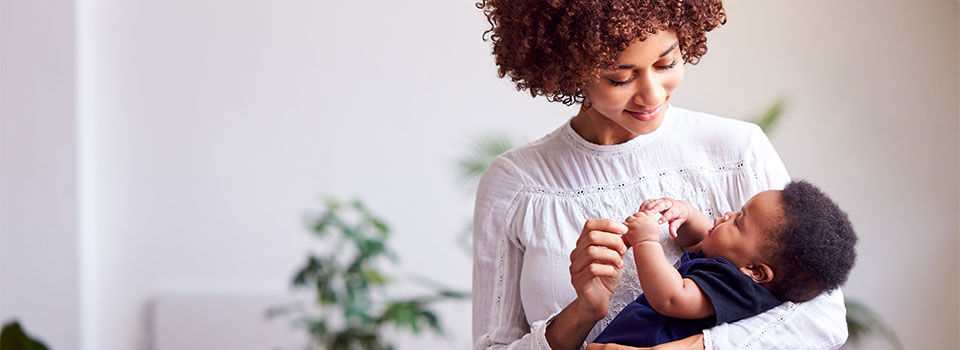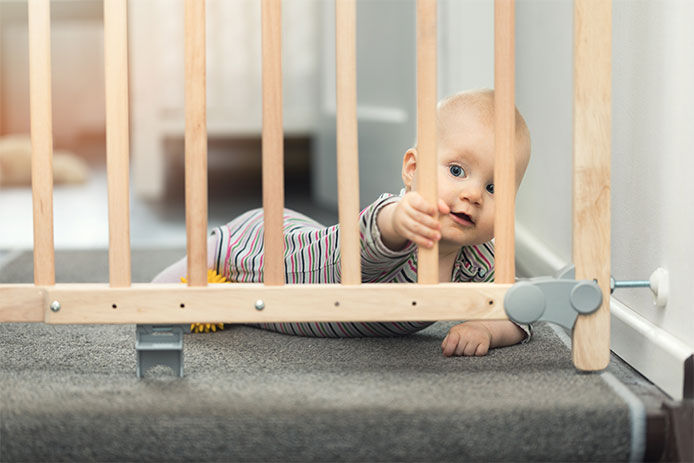How to Babyproof Your Home

When your first baby arrives home, it is a joyous and momentous occasion. But not only does your life change forever with this new precious arrival, so does your home. The guest room is now a nursery, hair products make way for diapers, and there’s a changing table in the hallway. With a new baby in your home, you suddenly begin to view the house through a different lens. Sharp corners and exposed wires you once never thought about are standing out. One of your top priorities as a parent is to ensure your new bundle of joy has a safe and secure place to live and grow. This necessity becomes all the more complicated when your baby begins crawling and you start to see your home not only as a lovely and cozy nest for your family but also as a whole new landscape where hazards and dangers lurk around every corner.
Babyproofing your home is one of the most important and inevitable steps in becoming a parent. While babyproofing is important regardless of what your house looks like, how you babyproof your home is going to depend on its layout, features, and objects within the house. While every family’s approach to babyproofing is unique and intuitive, we have some essential tips that will work for everyone.
Safety Gates

One of the most fundamental tools that will help you babyproof your home is the safety gate. Safety gates come in a wide variety of sizes, designs, and functionality and will be indispensable in keeping your baby safe. A safety gate will ensure your baby stays in a safe, supervised room and out of rooms where there are hazards. Many families opt for several safety gates to keep their babies safe. Two other key places where safety gates should go are at the top and bottom of stairs. Once babies start exploring, they are fascinated by just about anything, including staircases. A safety gate at the top and bottom of the stairs will prevent them from exploring the stairs all on their own.
Covers, Bumpers, and Knobs

Once you have a baby, it is shocking to learn of all the perilous places in your house that once seemed benign. Many things inside your home need to be covered properly so that your baby doesn’t hurt themselves. Any furniture or walls with sharp corners should be covered by bumpers to minimize any booboos from head bumps or falls.
Anything electric and easily accessible, such as outlets, wires, and plugged-in appliances, needs to be covered or put away. Exploring babies will be quick to stick their fingers into outlets, tangle themselves in wires, or unplug and play with anything they find. Be sure to install outlet covers on exposed outlets, and ensure wires and plugged-in objects are safely out of reach or protected.
Doorknobs, cabinet knobs, and stove knobs can be hazards — install knob covers to make them babyproof. Additionally, be sure to cover the faucets in your tub with a bumper to prevent head bumps.
Heavy Objects, Small Objects, and Loose Objects

Seemingly harmless objects can suddenly become harmful when you have a baby around. Big objects, small objects, and loose objects are all potential hazards. Babies love to play with just about anything they can get their hands on. Unfortunately, playing often includes putting items in their mouths. Be sure to store smaller objects out of reach of adventurous babies. Generally, anything smaller than a ping-pong ball can be swallowed, so even if an object seems big enough, it’s better to tuck it away.
Large objects come with their own set of issues. Big or heavy objects can be pulled down or fall onto a baby. Heavy books, statues, paperweights, lamps, and anything else that is reachable from the floor can be a safety hazard. Perhaps it’s time to rearrange the living area and keep all those heavy objects somewhere else.
Loose objects such as tablecloths and curtain strings can also pose problems. Babies may be inclined to pull down tablecloths while trying to climb up or tangle themselves in the strings of curtains or blinds. Ditch the tablecloth and prop up any loose strings to make your space safer for your baby.
Secure Doors, Cabinets, and Furniture

Eventually, doors, cabinets, and furniture will become liabilities to your crawling baby. Doors can easily close on fingers, so they should be kept secured and closed. Once your baby learns how to open the doors, you will want to babyproof your doors with doorknob and handle locks.
Cabinets pose a big problem to new parents. This challenge is especially true for kitchen and bathroom cabinets. Bathrooms, in general, are like landmines for crawling babies. Bathtub edges, toilets, faucets, and cleaning products to chew on make for a parent’s worst nightmare. It is good to get into the habit of keeping bathroom doors closed and secured at all times. Kitchen cabinets can also have toxic cleaning products and other items inside them. Be sure to install babyproof locks on all cabinets that are accessible to your baby.
As babies learn to crawl, they will want to crawl across the floor and also up furniture. Affix any shelves, bureaus, or cabinets that can act as a jungle gym to the walls to prevent the furniture pieces from landing on top of your baby.
When you bring your first child home, life changes forever, and so does the home front! Take the time to logically and intuitively adjust your living space so that your bundle of joy has the safest and most secure place to explore and discover while growing up.